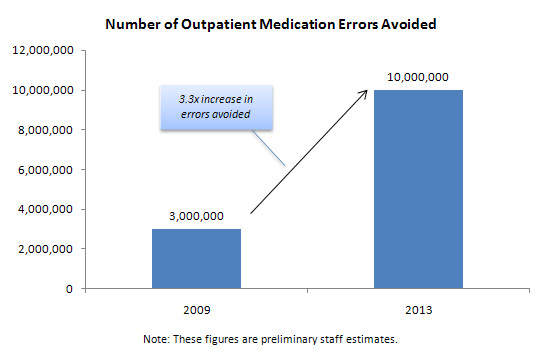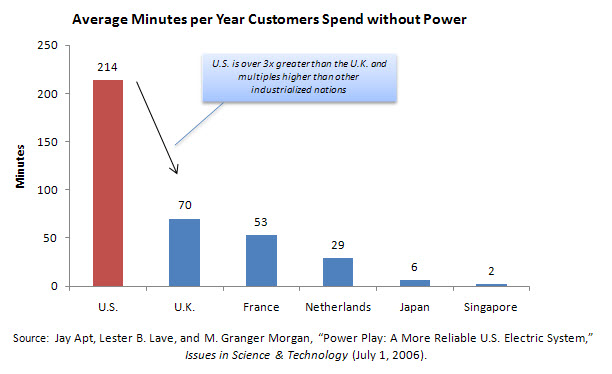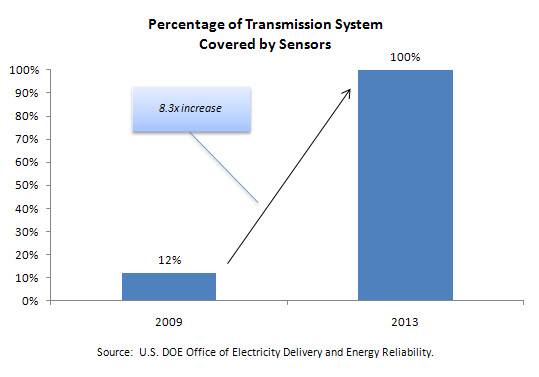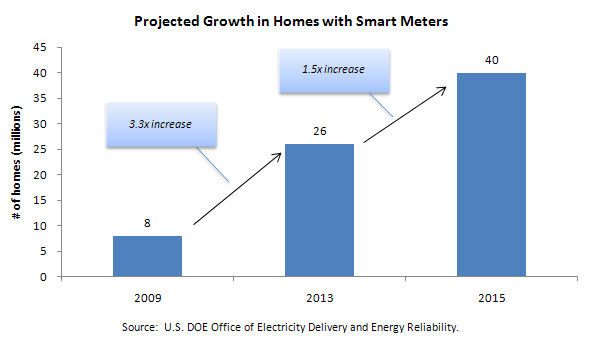Building a Platform for Private Sector Innovation: Investments in Broadband, Smart Grid, and Health Information Technology
Home | Executive Summary | Introduction | Transportation | Renewable Energy | Private Sector | Medical Research
Just as Recovery Act funds and private dollars are accelerating the rate of technology innovation for vehicles, batteries, and renewable energy, Recovery Act investments are leveraging private funds to accelerate the build out of a 21st century infrastructure – from fiber lines in underground trenches to wireless towers that beam signals across large distances. Not only are many of these investments innovative, but they can be transformative. They will create a platform for further innovation and entrepreneurship across all sectors of the economy and address many of the country's priorities including clean energy, health care, education, and public safety.
Broadband
High-speed internet, also known as broadband, is on of the great infrastructure challenges of the 21st century, akin to electricity during the last century. By investing in broadband, the U.S. is laying the groundwork for sustainable economic growth, well-paying jobs, and global competitiveness, as well as enabling technologies that will allow for innovations that today cannot be anticipated. Broadband is also a central component to addressing America’s health care, education, and energy challenges.
Fueled primarily by private sector investment and innovation, the American broadband ecosystem has advanced rapidly. The ten largest network service providers have annual capital investments in excess of $50 billion.35 The results of these investments are impressive: in 2000, only eight million Americans had broadband at home; by 2009, that number had grown to 200 million.36
But more needs to be done. Approximately 100 million Americans still do not have broadband at home.37 They are operating with a 20th century infrastructure in a 21st century economy.
The Recovery Act provides $6.9 billion to expand broadband access and adoption. More than $2.5 billion of this investment has gone to the Department of Agriculture to focus exclusively on infrastructure projects that help bring broadband access to rural and remote communities in America. The remaining $4.4 billion has gone to the Department of Commerce to support infrastructure projects that benefit anchor community institutions (e.g. hospitals, schools), public safety broadband networks, state broadband mapping and planning efforts, public computing centers, and sustainable broadband adoption. Awardees will build out broadband infrastructure, teach Americans the skills necessary to use high-speed Internet, and outfit public computing centers to provide easier access to high-speed Internet.
Case Study: The North GA Network Cooperative
State: Georgia
Funds:
- Federal Government: $33 million
- Recipient Match: $9 million
Award Date: December 17, 2009
Description of Award:
The project—encompassing 42,000 households, 9,200 businesses and 367 community anchor institutions—intends to enable a new technology-based economy in North Georgia by deploying a 260-mile regional fiber-optic ring and improving broadband service in underserved areas, while stimulating economic growth and job creation in eight counties in the North Georgia foothills.
Examples of Benefits:
- North Georgia College and State University (NGCSU) will be able to offer Internet-based language and other educational programs to numerous high schools in the region.
- A Lumpkin County business that provides rapid-response laboratory analysis for dozens of rural Georgia hospitals, surgical centers, and doctor’s clinics will be able to expand its business and create 300 new jobs, eventually fueling a new $40 million dollar economy from its Dahlonega offices.
- The project will allow for distance learning and parent-student-teacher interaction by bringing broadband to the estimated 13-30 percent of families with children that do not have broadband Internet access at home.
- The project will give eight counties in the North Georgia region the broadband tools they need for serious economic development.
- Region will be more competitive in recruiting businesses and allows for current businesses to pursue expansion plans.
Broadband in Rural America
In 1936, as part of his New Deal, President Franklin D. Roosevelt signed the Rural Electrification Act, which brought electricity to rural America and transformed the way business and life was conducted. Today, many Americans still remember the results of those policies – the day their small town lit up for the first time and the 20th century officially arrived.
Broadband in Rural America: One Economy’s Greene County Case Study
Greene County, North Carolina is a rural economically distressed county, with 20.2 percent of the population below the poverty line as of 2000. In November of 2003, Greene County leadership teamed up with the One Economy Corporation to implement Internet tools, including a contract to provide high-speed broadband access to everyone in the county.
The results have been dramatic. Within five years, average SAT scores among high school students increased from 930 to 971. Further, 84 percent of the 2007 senior class applied to college, compared to 26 percent in 2003. Within one year, the number of businesses with Internet presence jumped from 2.5 percent to 25 percent. And 20 new businesses were opened within two years, after several years of negative growth.
Inspired by these demonstrated successes, the Department of Commerce’s Broadband Technology Opportunities Program (BTOP) announced a $28.5 million grant to One Economy Corporation, in partnership with the Broadband Opportunity Coalition. They were able to secure $23 million in private sector matching funds, meaning they will implement $51.5 million in broadband initiatives throughout the U.S., drawing on lessons learned from Greene County and several other similar broadband projects.
Source: One Economy Corporation, www.one-economy.com.
Decades later, as the U.S. continues to move forward in to a new century, the Recovery Act has committed to bring broadband to those same rural areas. As Agriculture Secretary Tom Vilsack stated, this broadband investment "will give rural Americans access to the tools they need to attract new businesses, educational opportunities, and jobs.”
Rural residents in particular gain from broadband access. A 2009 report from the Department of Agriculture found that total employment grew faster in counties with robust broadband Internet access than in similar rural counties with limited broadband Internet access. 38 Some experts fear that communities without access to broadband internet are missing important activities in their region that are largely organized and facilitated online.39 In addition, the use of broadband can reduce the burden and cost of traveling by using telemedicine to bring the best health care to rural America and distance learning to bring the best education to rural America.
In all, USDA’s $2.5 billion from the Recovery Act, together with non-federal leverage, will bring broadband to millions of Americans, hundreds of thousands of businesses and tens of thousands of community anchor institutions like hospitals and schools across rural America. 40 Because USDA has the benefit of making loans in conjunction with grants, the total amount of money the agency is able to put out the door actually exceeds their $2.5 billion in authority. This is evident in the numbers already. As of August 18, 2010, USDA had awarded roughly $3 billion – an investment that is supporting more than $3.3 billion in total activity. More than 4 million people stand to benefit from these already-awarded projects alone, as do over 25,000 community anchors and more than 310,000 businesses.

Broadband will help small businesses in rural America thrive and expand by giving them access to global markets. Internet access provides resources to help today’s farmers and ranchers compete in an increasingly online world. With broadband access, a producer can now log on to the Internet every day and get immediate access to real-time commodity pricing, as well as consumer information and weather forecasts. This means that a rancher in Iowa can sell cattle to a buyer in Texas without the prohibitive costs of travel or delay of information preventing it. These opportunities allow ranches across the country to compete on a more level playing field with large corporations that have long had these advantages. Broadband has also proven to be an effective venue for advertising, generating business, and identifying new opportunities, especially for small businesses and the self-employed. With the development of these online tools, the face of the agricultural industry is changing; these broadband investments are helping propel America’s farmers into that future.
In one instance in rural Georgia, access to broadband has allowed a community to preserve fresh water and manage the water supply efficiently. Farmers have been able to access current data relating to soil moisture readings and rainfall quantities using the broadband network. This information has allowed them to make changes to the amounts of water used to irrigate their crops. The increased data, accessed through the broadband network, has enabled farmers to save 267 million gallons of water over a two-year period, lowering their costs and decreasing their impact on the environment.41
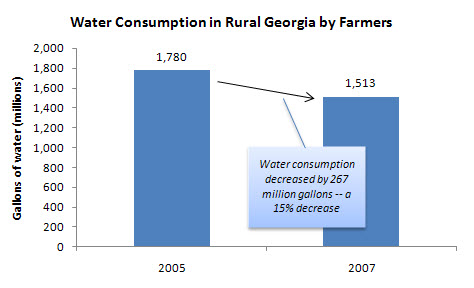
Source: Christine Griffiths, “Conservation Goes Wireless to Preserve Fresh Water,” The Nature Conservancy: Where We Work.
Better Broadband Everywhere
Rural America is not the only community that would benefit from improved access to broadband. While it is critical to achieve access for Americans who are currently unserved, it is equally important to ensure there are more robust networks throughout the country. And beyond networks, it is important that Americans have the hardware and skills needed to use broadband productively.
Awards from the Department of Commerce target a number of goals: providing a backbone for high-speed connectivity to unserved and underserved areas, offering community institutions affordable bandwidth, promoting sustainable broadband adoption in areas where broadband is available, and supporting public computing centers.
Each of these goals supports and encourages innovation, giving a digital platform and tools to entrepreneurs, creating new markets that increase demand for existing and new products, and offering ultra-high-speed access to researchers who need it.
As of August 18, 2010, the Department of Commerce has invested $2.78 billion in broadband networks across the country. This includes investments of $125 million in public computing, and $157 million in sustainable adoption programs that include digital literacy training and outreach campaigns.
By increasing the amount of broadband capacity to communities throughout the U.S. and increasing the number of people who recognize the value of and can use high-speed Internet, the Recovery Act is laying the foundation for greater economic opportunities.
That foundation enables entrepreneurs and innovative businesses to take risks and make investments. As a consequence, technology is developed, new products are sold, and more private sector capital is brought off the sidelines. In the health sector, broadband usage can improve the quality of health care while reducing health care costs. And in the energy sector, broadband and other communications systems can improve energy usage at home and at the workplace, increasing efficiency and reliability.
Investments in technology like broadband have helped keep the United States at the center of innovation and kept U.S. companies and its workers competitive around the world. The investments that were started in 2009 and will continue through 2010 will expand and enhance the critical infrastructure that forms the country’s information backbone. These enhancements will play a key role in a broader revitalization of communities and businesses across rural America.
Health Information Technology
Broadband enables advancements in health care including electronic health records (EHRs), e-prescribing, and e-care. The Recovery Act itself is investing over $20 billion in Health Information Technology (IT) that will give a significant boost to these advancements. Approximately $2 billion is being spent largely to support ready hospitals, providers, states, and other parties to adopt Health IT.40 The remaining funds will be used to incentivize physicians and providers to adopt Health IT in 2011 and beyond.
Beacon Communities
Of the $2 billion in upfront Health IT spending, approximately $250 million is dedicated to the Beacon Community program to showcase how Health IT, when used in combination with other delivery system improvements, can transform the ways in which communities manage health and unlock previously unrealized health outcome benefits.
In May 2009, 15 communities from across the country received Beacon Community awards for this purpose. These communities will use data to inform the implementation of their plans, targeting specific, measurable, and innovative health care improvements. These pilot communities will serve as examples for other communities in how to use health IT to make marked and sustainable improvements in health care quality, safety, and efficiency.
Three examples below illustrate the kinds of transformations expected in the health care systems of the selected Beacon Communities.44

Download CSV (Emergency Department Visits)
Download CSV (Costs Due to Emergency Department Visits)

Download CSV (People at Risk of Heart Attacks or Strokes)
Download CSV (Pediatric Asthmatic ED Visits)
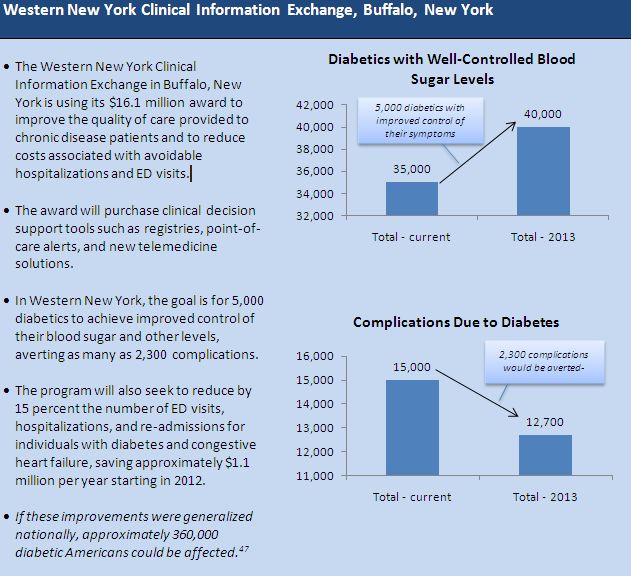
Electronic Health Records and E-prescribing
The Administration is committed to promoting the adoption of electronic health records (EHRs) due to their ability to improve health outcomes and decrease costs. Increasing electronic health record adoption will facilitate medical professionals’ use of EHRs to place “e-prescriptions.” Much like the advent of bar code scanners in supermarkets, a technology that now most of the country cannot imagine living without, e-prescribing is convenient for consumers; lowers administrative expenses for physicians and pharmacists; and reduces a component of manual error, thereby increasing patient safety. Patients can readily appreciate the convenience of a prescription being sent to their pharmacy of choice before they even leave the doctor and the security of knowing that the doctors’ handwriting will not be misread by the pharmacy staff. Physicians can avoid many of the hassles of pharmacy call-backs for formulary substitutions and refill requests. Both groups can benefit from advanced e-prescribing functions that can, for example, check for potential adverse interactions with other drugs currently prescribed for the patient. Finally, e-prescribing has the potential to reduce certain unnecessary medical costs and improve health outcomes: one study estimates tens of billions of dollars in savings to federal programs over the period 2009-2018 from e-prescribing alone, due to reductions in drug costs, adverse drug events, and better adherence.48
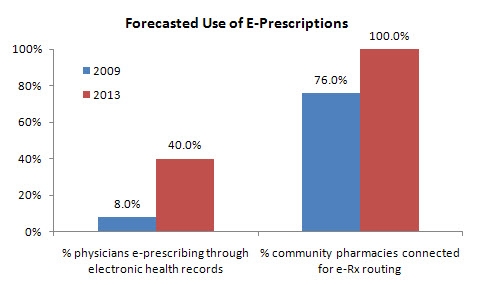
2009 Data Source: SureScripts, “Advancing Healthcare in America: 2009 National Progress Report on E-Prescribing, Plus What’s Ahead in 2010 and Beyond, http://www.surescripts.com/media/515306/2009_national-progress-report.pdf (accessed August 20, 2010).
2013 Data Source: Health and Human Services, Office of the National Coordinator for Health Information Technology.
These innovations are important for their demonstrated ability to improve health outcomes and reduce certain costs. Medication errors and the adverse drug events that result from them are common, harmful, and preventable: studies have estimated that 2.4 – 3.6 percent of hospitalizations are caused by adverse drug events of which more than two-thirds could have been prevented.49 These events are also costly; the estimated average cost of a preventable adverse drug event in older adults was $1,983, and the national annual costs were estimated to be $887 million in 2000.50
At the end of 2008, an estimated three million outpatient medication errors were avoided through the use of e-prescribing technology. Supported by funding in the Recovery Act, that number is projected to be over 10 million errors by 2013.51
As more institutions increase their interest and investments in healthcare information technology, the private sector is responding with investments in innovation. According to Dow Jones VentureSource, in the second quarter of 2010, there was a 91 percent increase in venture capital funding for U.S.-based medical software and information services companies: investments jumped to $157 million from $82 million during the same quarter in 2009.52
E-Care Technologies and Telemedicine
Broadband enables the effective application of e-care technologies and telemedicine. E-care allows medical personnel to treat patients remotely. Specialists located in urban settings can use a high-speed broadband video connection to treat a patient located in a remote town. With high-speed broadband access, health care professionals can read tests and monitor chronic conditions remotely, as well as exchange diagnostic information between patients, their local providers, and specialists from other parts of the country. Studies demonstrate that e-care reduces health care costs and provides the benefits of advanced medical care to previously unserved or underserved populations.
Broadband also enables remote monitoring. Currently doctors monitor patients periodically in hospitals or physicians’ offices. Remote monitoring (via smart wireless band aids) allows for around the clock observation. The Department of Veterans Affairs has dramatically decreased unnecessary hospitalizations through a wide-ranging effort to help veterans manage chronic conditions at home.53,54 Hospital use was decreased 25 percent overall, and 50 percent for patients in highly rural areas, by linking 32,000 chronically ill veterans with health care providers and care managers through video phones, digital cameras, and messaging, and tele-monitoring.
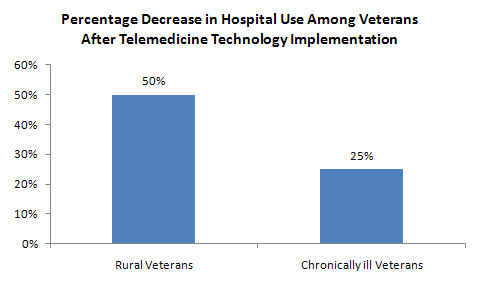
Source: See footnotes 53 and 54.
Download CSV
Smart Grid
Smart Grid technology combined with supportive policy allow for smarter use of energy, largely by increasing the transparency, measurement, and control of energy used by the various players who supply, transmit, and demand it. Through automated sensors and controls as well as dynamic pricing, this intelligent infrastructure will make the electric system more reliable, empower consumers and ultilities to use energy more wisely, help manage peak demand, enable larger scale use of renewable energy and electric vehicles, and reduce U.S. dependence on oil.
With the Smart Grid, utilities can significantly reduce service interruptions and the associated economic losses, which is important to consumers and the economy. The average U.S. customer loses power for 214 minutes per year. That compares to 70 minutes in the United Kingdom, 53 in France, 29 in the Netherlands, six in Japan, and two minutes per year in Singapore. These outage durations tell only part of the story. In Japan, the average customer loses power once every 20 years. In the United States, it is once every nine months, excluding hurricanes and other strong storms.55
In a 2004 study, the Lawrence Berkeley National Laboratory (LBNL) estimated the annual costs of U.S. power outages to be $22 to $135 billion.56 However, major black outs like the ones that the U.S. and Canada experienced in 2003 are not the main contributor to this annual cost. The study found that the costs of short interruptions of five minutes duration or less caused two-thirds of the economic losses. And of these losses, 72 percent are borne by commercial customers, whereas industrial customers shoulder 26 percent of the loss and residential users only two percent.
In a push that will bolster the integrity of the U.S. electric grid, the Recovery Act is accelerating the deployment of 21st century Smart Grid technologies in America’s electric infrastructure. The U.S. electric grid, named the greatest engineering accomplishment of the 20th century by the National Academy of Engineers, was not designed for today’s energy-intensive economy or increased electricity trade. As it operates today, the grid is increasingly stressed, which can result in reliability concerns, is vulnerable to storms and human disruptions, and confronting a new series of challenges with the use of more intermittent sources of energy generation such as wind power.
A smarter grid can help utilities reduce service interruptions and the associated economic losses. For example, smart technologies are capable of detecting events such as a line down due to a fallen tree and then alerting operators or triggering automatic responses. By improving the reliability of power, health and safety threats are lessened, economic losses are reduced, and quality of life improves.
To improve system reliability, the Recovery Act will install an additional 875 transmission system sensors, or “Phasor Measurement Units,” that can alert system operators and help prevent minor disturbances from cascading into large outages. Recovery Act funds will help install enough of these to cover the country’s entire transmission system.
For further system reliability, the Recovery Act funds will help equip 700 substations with automated devices to detect and respond to system irregularities help avoid outages. If an outage does occur, smart technologies can potentially speed the restoration of power, minimizing cost and inconvenience. Recovery Act funds also are being invested in the installation of over 200,000 advanced transformers capable of sensing conditions associated with failures and alerting system operators. When an alert is received, crews can be dispatched to repair or replace the transformer, thereby averting an outage.
Moreover, the Recovery Act recognized the opportunity to accelerate the deployment of components that make up a Smart Grid to support a modern, low-carbon economy and create a platform for innovation for new energy management and information services in homes and buildings. The combination of Recovery Act funds and private investments promise to add 18 million new smart meters to the eight million currently in use. This means 26 million smart meters will be in use by 2013 on track to reach 40 million by 2015 through public and private investment.
The two-way flow of information from the grid to customers creates new opportunities in the private sector for innovation in the development of tools for consumers. The development of these tools will enable both the utilities and consumers to use electricity more efficiently, thereby reducing their costs. Even at this early stage in the development of Smart Grid technology, these challenges have already spurred new technology development and business opportunities. Venture capital backed start-ups like OPower and large companies like GE are developing new products and services such as smart thermostats, smart appliances, in-home energy displays, energy management and information services. These tools utilize information from the Smart Grid to deliver value and convenience to customers.
In an effort to catalyze innovation in the Smart Grid ecosystem, the National Institute of Standards and Technology (NIST) at the Department of Commerce is spearheading the development of open interoperability standards, allowing new technologies and applications to support integration of distributed and renewable resources, give consumers new tools to reduce energy usage, and enhance the reliability and security of the grid. This work is supported by over $15 million in Recovery Act funding from the Department of Energy and Commerce. 57
Smart technologies and policies bring the system integration and balancing capabilities also needed for many of the innovations in the renewable energy and electric vehicle fields. Smart Grid technologies allow the reliable integration of energy generated and/or stored at distributed generation locations and on a smaller scale than considered feasible in the past. This lays the groundwork for “net metering” when consumers can both buy from and sell back to the grid from their own solar, wind, or other energy generation source.
For similar reasons, the Smart Grid can help establish the foundation for a large-scale shift to vehicles fuled by electricity. A smarter grid infrastructure is needed to support the demand for charging stations as more and more electric cars enter the market and reduce our national dependence on oil. Owners of electric vehicles will want the option to charge batteries when prices are low, and eventually, to offer them as energy storage options when generating capacity is at a premium. To make the system sufficiently flexible and responsive to meet these expectations, smart technologies must be in place to collect data and communicate signals to activate controls whenever market signals or owners dictate. There are already a number of innovative companies working on technology solutions to enable the seamless “smart charging” of electric vehicles.
The Recovery Act investment in Smart Grid is proving to have a powerful financial multiplier effect across the economy. In addition to the benefits linked to the deployment of smart devices, there also has been a positive impact on the U.S. manufacturing sector. The Recovery Act has invested $23.2 million in 48C tax credits to seven companies in Smart Grid-related manufacturing.58 A related Smart-Grid supply chain is emerging as a result of the billions of public and private dollars being invested.59 Device manufacturers have added workers to meet orders placed by recipients. Technology and software developers are coming up with solutions to new challenges associated with Smart Grid projects.
Orders linked to Recovery Act funding through the Smart Grid Investment, Regional Demonstration, and Storage Demonstration Grants are helping companies like Silver Spring Networks, Itron, and Cooper Power Systems invest in new plant construction as well as plant expansions and new equipment to meet the demand driven by innovation. The accelerating emergence of the Smart Grid devices market has created jobs at these facilities and all along the supply chain.
35 Mike McConnell, Op-Ed., “Mike McConnell on How to Win the Cyber-War We’re Losing,” Washington Post (Feb. 28, 2010), cited in Federal Communications Commission, “Connecting America: The National Broadband Plan (NBP),” 18.
36 Federal Communications Commission, “Connecting America: The National Broadband Plan (NBP),” xi.
37 Ibid.
38 Peter Stenberg, Mitch Morehart, Stephen Vogel, John Cromartie, Vince Breneman, and Dennis Brown for the United States Department of Agriculture, “Broadband Internet’s Value for Rural America,” USDA Economic Research Service, Report Number 78 (August, 2009).
39 “Rural Broadband at a Glance, 2009 Edition.” USDA Economic Research Service, Economic Bulletin Number 47 (February, 2009).
40 USDA’s $2.5 billion is in both grants and loans. Due to the loan portion of the portfolio, USDA’s support for broadband expansion could total nearly $3.6 billion.
41 Christine Griffiths, “Conservation Goes Wireless to Preserve Fresh Water,” The Nature Conservancy: Where We Work.
42 These funds will be appropriated to the Office of the National Coordinator of Health Information Technology at the Department of Health and Human Services.
43 The Recovery Act’s total Health IT expenditures starting in 2011 will be determined largely on the number and timing of hospitals and providers who meaningfully adopt health IT and thus who qualify to receive incentive payments for doing so, or incur penalty payments for failing to do so.
44 Data is drawn from original applications for HHS Recovery Act Health IT Funds.
45 National estimate is a preliminary staff estimate extrapolated from Kaiser State Health Facts.
46 National estimate is a preliminary staff estimate extrapolated from published industry sources.
47 National estimate is a preliminary staff estimate extrapolated from CDC diabetes data. http://apps.nccd.cdc.gov/DDTSTRS/default.aspx (accessed August 20, 2010).
48 Visante, “American Recovery and Reinvestment Act Will Save Billions and Reduce Medication Errors by Accelerating E-Prescribing” (2009),
http://pcmanet.org/wp-content/uploads/2009/03/final-arra-impact-on-eprescribing.pdf (accessed August 20, 2010).
49 Angela Schedlbauer, Vibhore Prasad, Caroline Mulvaney, Shobha Phansalkar, Wendy Stanton, David W. Bates, Anthony J. Avery, “What evidence supports the use of computerized alerts and prompts to improve clinicians' prescribing behavior?,” Journal of the American Medical Informatics Association 16 (4), (July-August, 2009): 531-8.
50 Terry S. Field, Boyd H. Gilman, Sujha Subramanian et al. “The Costs Associated with Adverse Drug Events Among Older Adults in the Ambulatory Setting,” Medical Care 43, no. 12 (2005): 1171-6.
51 A recent controlled trial of e-prescribing found a baseline rate of prescribing errors of 3.4 percent in an ambulatory setting was reduced to 1.8 percent in the e-prescribing intervention sites. (The rate in the control sites was unchanged during the study period.) Personal communication, David Bates MD, April 19, 2010. These findings were applied to SureScripts data on total medication transactions to extrapolate these estimates.
52 Nicole Lewis, “VC Investment in Medical Software, Information Services Soars,” InformationWeek (July 21, 2010), http://www.informationweek.com/news/healthcare/EMR/showArticle.jhtml?articleID=226100026&queryText=investment%20and%20in%20and%20healthcare (accessed August 20, 2010).
53 Huanguang Jia, et al. “Long-Term Effect of Home Telehealth Services in Preventable Hospitalization Use,” Journal of Rehabilitation Research and Development 46, no. 5 (2008): 557-566.
54 A. Darkins, et al. “Care Coordination/Home Telehealth: The Systematic Implementation of Health Informatics, Home Telehealth, and Disease Management to Support the Care of Veteran Patients with Chronic Conditions,” Telemedicine and e-Health 14, no. 10 (2008): 1118-1126.
55 Jay Apt, Lester B. Lave, and M. Granger Morgan, “Power Play: A More Reliable U.S. Electric System,” Issues in Science & Technology (July 1, 2006).
56 Kristina Hamachi LaCommare and Joseph H. Eto, “Understanding the Cost of Power Interruptions to U.S. Electricity Consumers,” Ernest Orlando Lawrence Berkeley National Laboratory, University of California Berkeley, Energy Analysis Department (September 2004).
57 National Institute of Standards and Technology, “Smart Grid Interoperability Standards Project,” http://www.nist.gov/smartgrid (accessed August 20, 2010).
58 Cooper Power Systems, Nacogdoches, TX & Waukesha, WI; Ice Energy, Inc. Hammondsport, NY; Itron, Inc. West Union, S.C.; Metglas, Inc.; Premium Power, North Reading, MA; S&C Electric Company, Chicago, IL.; and Southwire, Carrollton, GA.
59 According to the Council of Economic Advisers’ 2010 Fourth Quarterly Report, the Recovery Act invested $4.5 billion in Smart Grid, spurring an additional $6 billion in private sector investment (http://obamawhitehouse.archives.gov/files/documents/cea_4th_arra_report.pdf, accessed August 20, 2010).

